If you own an electric mountain bike, you understand the importance of range. That’s the distance you can travel on a single battery charge. It’s crucial, especially when you’re tackling tough trails or planning a long day of riding.
The range of your e-bike is influenced by several factors. One significant factor is battery capacity, measured in watt-hours (Wh). A larger capacity generally means more miles between charges. But don’t forget bike efficiency, which includes the motor’s performance, the bike’s weight, and even the rolling resistance of your tires.
Conserve battery life by optimizing your riding style. For instance, use lower assist levels on flat terrain and save those higher levels for steep climbs. Plan your route intelligently, avoiding unnecessary detours. Regular maintenance also helps, like keeping your chain clean and well-lubricated.
But what if you’re planning an exceptionally long trip, or you just don’t want to worry about running out of juice? Here’s a tip: ADD A SECOND BATTERY. It’s a straightforward solution that doubles your range.
You might wonder, how does carrying an extra battery affect riding? It adds weight and can change the bike’s balance. But many riders find the trade-off well worth it for the peace of mind and extra miles. Just make sure you have a safe, secure place on your bike to carry the spare.
Navigating Battery Life and Replacement Costs
It’s crucial to understand the lifespan of electric mountain bike batteries. Like all rechargeable units, these power sources wear out over time. Factors such as charge cycles, storage conditions, and usage habits greatly shape their longevity. I’ll walk you through the signs of battery degradation. These might include diminished range, longer charging times, and reduced power output.
Proper maintenance is key to extending battery life. I recommend following best practices such as avoiding extreme temperatures, keeping the battery charged to an optimal level, and avoiding running it completely flat. I realize it’s tempting to push limits, but for the sake of your battery, a little caution goes a long way.
Eventually, every rider faces the replacement question. The cost of a new battery can be considerable, often a significant percentage of the bike’s original price. Yet, investing in quality can save you money in the long run. Cheaper options might entice you, but consider their performance and durability before making a decision.
Considering purchasing a spare? Carrying an extra battery can be practical for long treks. However, it adds to the bike’s weight and can alter handling. It’s a trade-off; more range versus a bit less agility. Determine what balance works for you depending on the length and terrain of your rides.
In conclusion, an informed approach to electric mountain bike battery life and management not only enhances your rides but also safeguards your investment. Pay attention to your battery’s health, practice diligent upkeep, and when the time comes, choose a replacement that ensures many more miles of thrilling mountain biking adventures.

